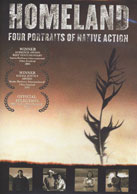
Homeland: Four Portraits of Native Action 2005
Distributed by Bullfrog Films, PO Box 149, Oley, PA 19547; 800-543-FROG (3764)
Produced by Roberta Grossman
Directed by Roberta Grossman
VHS, color, 88 min.
Jr. High - Adult
American Studies, Environmental Studies, Human Rights, Native American Studies
Date Entered: 10/10/2005
Reviewed by Meghann Matwichuk, Morris Library, University of DelawareHomeland is an enlightening and well-constructed program which tells the story of several Native American tribes and their struggles to protect and care for their ancestral lands. By focusing on three activists and one activist couple, the filmmaker provides a personalized view of four communities as they rally against new initiatives by energy companies and a paper mill that have historically laid waste to their lands. (One expert uses the phrase “environmental racism” to describe the human rights violations inherent in many of these industrial endeavors.) It shows how environmental regulations have been undermined in recent years by presidential administrations that prioritize industry over the health and welfare of its native people and strikingly portrays the consequences. The program references the energy crisis of the 70s and its environmental toll; in the face of another impending energy crisis, Homeland could not have been released at a more relevant time.
An emotive score laced with native tones complements the often breathtaking footage of the threatened natural landscapes. Historical photographs and footage lend the viewer a sense of the scope and longevity of the struggles of native peoples. Commentary by perhaps the most well-known Native American activist, Winona LaDuke, punctuates and contextualizes the challenges facing the different tribes. The scientific processes that lead to environmental degradation are succinctly explained by geologists and other experts. All of these elements create a clear picture of how the Native Americans’ spiritual connection to their homeland and way of life is threatened by unsustainable, harmful practices that affect us all.
Subtle undercurrents throughout all four stories emerge as major themes. Although the tribes live in the poorest areas of the country, they resist pressure to sell their lands at a great profit to corporate interests. This provides striking evidence of the power of grassroots democratic action and leaves the viewer with a sense of hope. Tribal leaders find that their most important weapon lies in their abilities to organize and inform their communities of the dangers that threaten their way of life. The film makes clear that pressure must be brought to bear by members of those communities affected. Because the native peoples live in such close harmony with their surroundings, they are on the front lines of this environmental battle. LaDuke leaves the viewer with a portentous warning: “Our reality is your reality.” Despite the American peoples’ apparent willingness to turn a blind eye, Homeland underscores that we are all affected by the damage that is being inflicted on this land.